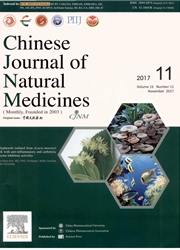

 中文摘要:
中文摘要:
目的:研究普洱熟茶(发酵)和普洱绿茶(未发酵)这 2 种常见普洱茶的抗 HIV 作用。方法:采用 MTT 比色法检测普洱茶提取物对 C8166, MT4 和 PBMC 细胞的毒性作用; 细胞病变法检测化合物对 HIV-1 急性感染的抑制活性。采用细胞病变法和 HIV-1 p24 抗原 ELISA 方法检测普洱茶提取物的抗 HIV 活性作用; 结果:所有普洱茶提取物都具有较低的细胞毒性 CC50为 120.63 524.95 μg·mL 1。所有普洱茶提取物均能抑制 HIV 诱导细胞形成合胞体其 EC50为 11.13 67.49 μg·mL 1。普洱茶水提物的抑制作用比醇提物的抑制作用要好, 并且普洱熟茶的抑制作用好于普洱生茶, 尤其是 YYP-31, 其 SI 值为 42.40。YYP-31 对HIV-RF和 HIV-2CBL-20也有很好的抑制作用, 其 EC50分别为 30.82 和 39.79 μg·mL 1。YYP-31 还能很好地抑制 HIV-1IIIB急性感染C8166 细胞和 HIV-1KM018感染PBMC细胞p24抗原的产生, 其EC50分别为14.95和 74.63 μg·mL 1。YYP-31能阻止正常细胞C8166与 HIV-1 慢性感染细胞 H9/HIV-1IIIB之间的融合, EC50为 234.27 μg·mL 1。提取物 YYP-31 与 AZT 联合用药具有显著的协同抗HIV 作用,但是对 HIV 逆转录没有抑制作用。结论:普洱茶提取物具有很好的抗 HIV 的活性作用, 可以作为一种 HIV 辅助治疗的产品或保健品用于 HIV 患者的治疗过程中。
 英文摘要:
英文摘要:
AIM: To evaluate the anti-H1V activities of extracts from two commonly forms of Pu-erh tea (fermented), green tea-like (unfermented). METHODS: The cytotoxicities of extracts on C8166, MT4 and PBMC were assessed by MTT and the anti-HIV activities of extracts were evaluated by syncytium reduction and p24 antigen assay. RESULTS: All extracts had low cyto- toxieities with the CC50 from 120.63 to 524.95 μg-mL-1. All extracts can inhibit HIV-induced cytopathic effects, with ECs0 various from 11.13 to 67.49 μg.mL-1. The WEPT's were better than EEPTs, moreover the FPT's water extracts were better than the GTLPT's especially YYP-31 with SI value 42.40. YYP-31 also inhibited HIV-1RF and HIV-2cBL-20 infection with EC50 of 30.82 and 39.79 μg-mL-1, respectively. YYP-31 reduced p24 antigen expression in HIV-1Hm acute infected C8166 and in HIV-1KM018 infected PBMC with EC50 values of 14.95 and 74.63 μg.mL-1, respectively. YYP-31 blocked the fusion between normal C8166 ceils and HIV-1 chronically infected H9 cells with EC50 values of 234.27 μg.mL-1. It exhibits markedly synergistic anti-HIV activity in combination with AZT but can't inhibit activities of reverse transcriptase. CONCLUSION: Pu-erh tea extracts exhibit highly efficient anti-HIV-1 activity and can be considered to be used to as a complementary therapy or a health product to HIV patients.
 同期刊论文项目
同期刊论文项目
 同项目期刊论文
同项目期刊论文
 The depolymerized fucosylated chondroitin sulfate from sea cucumber potently inhibits HIV replicatio
The depolymerized fucosylated chondroitin sulfate from sea cucumber potently inhibits HIV replicatio Engineering a switch-on peptide to ricin A chain for increasing its specificity towards HIV-infected
Engineering a switch-on peptide to ricin A chain for increasing its specificity towards HIV-infected Wikstroelide M potently inhibits HIV replication via targeting reverse transcriptase and integrase n
Wikstroelide M potently inhibits HIV replication via targeting reverse transcriptase and integrase n DB-02, a C-6-cyclohexylmethyl substituted pyrimidinone HIV-1 reverse transcriptase inhibitor with na
DB-02, a C-6-cyclohexylmethyl substituted pyrimidinone HIV-1 reverse transcriptase inhibitor with na Synthesis of New 2-(N-Arylsulfonylindol-3-yl)-3-aryl-1,3-thiazolidin-4-ones as HIV-1 Inhibitors In V
Synthesis of New 2-(N-Arylsulfonylindol-3-yl)-3-aryl-1,3-thiazolidin-4-ones as HIV-1 Inhibitors In V Discovery of a novel HIV-1 integrase inhibitor from natural compounds through structure based virtua
Discovery of a novel HIV-1 integrase inhibitor from natural compounds through structure based virtua Design and discovery of flavonoid-based HIV-1 integrase inhibitors targeting both the active site an
Design and discovery of flavonoid-based HIV-1 integrase inhibitors targeting both the active site an 1, 4-bis (5-(naphthalen-1-yl)thiophen-2-yl)naphthalene, a small molecule, functions as a novel anti-
1, 4-bis (5-(naphthalen-1-yl)thiophen-2-yl)naphthalene, a small molecule, functions as a novel anti- Discovery of Allosteric Inhibitors to Block Interactions of HIV-1 Integrase with Human LEDGF/p75 via
Discovery of Allosteric Inhibitors to Block Interactions of HIV-1 Integrase with Human LEDGF/p75 via 期刊信息
期刊信息
